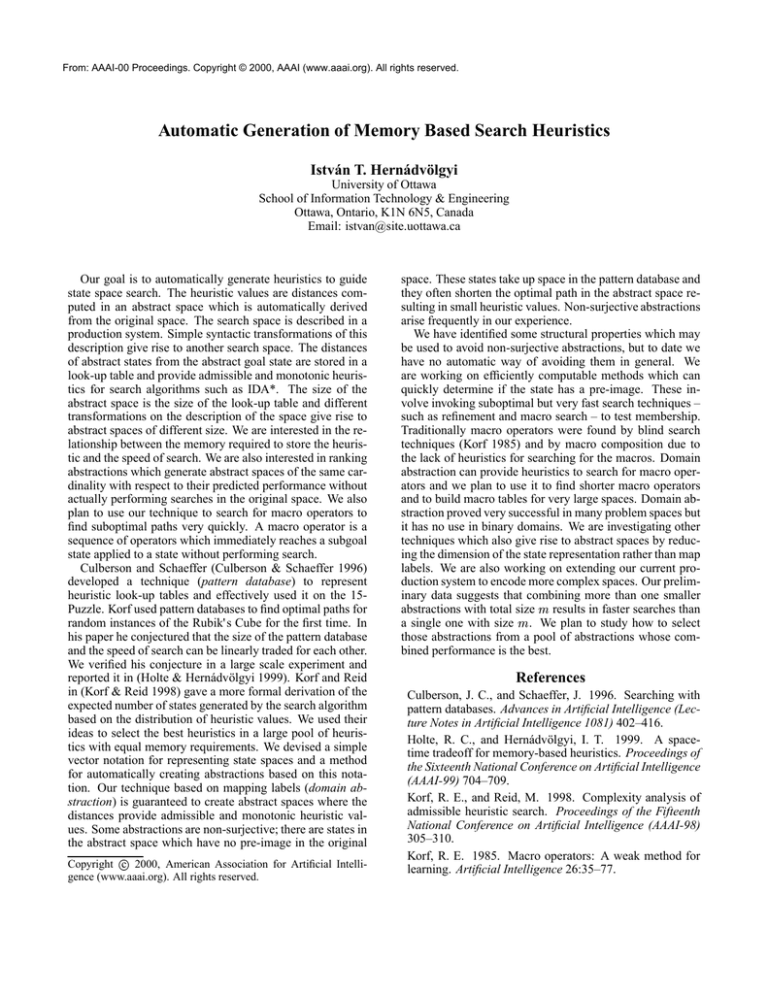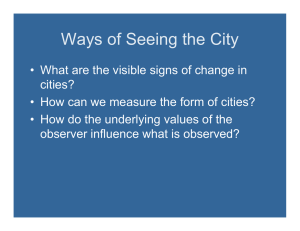
From: AAAI-00 Proceedings. Copyright © 2000, AAAI (www.aaai.org). All rights reserved.
Automatic Generation of Memory Based Search Heuristics
István T. Hernádvölgyi
University of Ottawa
School of Information Technology & Engineering
Ottawa, Ontario, K1N 6N5, Canada
Email: istvan@site.uottawa.ca
Our goal is to automatically generate heuristics to guide
state space search. The heuristic values are distances computed in an abstract space which is automatically derived
from the original space. The search space is described in a
production system. Simple syntactic transformations of this
description give rise to another search space. The distances
of abstract states from the abstract goal state are stored in a
look-up table and provide admissible and monotonic heuristics for search algorithms such as IDA*. The size of the
abstract space is the size of the look-up table and different
transformations on the description of the space give rise to
abstract spaces of different size. We are interested in the relationship between the memory required to store the heuristic and the speed of search. We are also interested in ranking
abstractions which generate abstract spaces of the same cardinality with respect to their predicted performance without
actually performing searches in the original space. We also
plan to use our technique to search for macro operators to
find suboptimal paths very quickly. A macro operator is a
sequence of operators which immediately reaches a subgoal
state applied to a state without performing search.
Culberson and Schaeffer (Culberson & Schaeffer 1996)
developed a technique (pattern database) to represent
heuristic look-up tables and effectively used it on the 15Puzzle. Korf used pattern databases to find optimal paths for
random instances of the Rubik's Cube for the first time. In
his paper he conjectured that the size of the pattern database
and the speed of search can be linearly traded for each other.
We verified his conjecture in a large scale experiment and
reported it in (Holte & Hernádvölgyi 1999). Korf and Reid
in (Korf & Reid 1998) gave a more formal derivation of the
expected number of states generated by the search algorithm
based on the distribution of heuristic values. We used their
ideas to select the best heuristics in a large pool of heuristics with equal memory requirements. We devised a simple
vector notation for representing state spaces and a method
for automatically creating abstractions based on this notation. Our technique based on mapping labels (domain abstraction) is guaranteed to create abstract spaces where the
distances provide admissible and monotonic heuristic values. Some abstractions are non-surjective; there are states in
the abstract space which have no pre-image in the original
Copyright c 2000, American Association for Artificial Intelligence (www.aaai.org). All rights reserved.
space. These states take up space in the pattern database and
they often shorten the optimal path in the abstract space resulting in small heuristic values. Non-surjective abstractions
arise frequently in our experience.
We have identified some structural properties which may
be used to avoid non-surjective abstractions, but to date we
have no automatic way of avoiding them in general. We
are working on efficiently computable methods which can
quickly determine if the state has a pre-image. These involve invoking suboptimal but very fast search techniques –
such as refinement and macro search – to test membership.
Traditionally macro operators were found by blind search
techniques (Korf 1985) and by macro composition due to
the lack of heuristics for searching for the macros. Domain
abstraction can provide heuristics to search for macro operators and we plan to use it to find shorter macro operators
and to build macro tables for very large spaces. Domain abstraction proved very successful in many problem spaces but
it has no use in binary domains. We are investigating other
techniques which also give rise to abstract spaces by reducing the dimension of the state representation rather than map
labels. We are also working on extending our current production system to encode more complex spaces. Our preliminary data suggests that combining more than one smaller
abstractions with total size results in faster searches than
a single one with size . We plan to study how to select
those abstractions from a pool of abstractions whose combined performance is the best.
References
Culberson, J. C., and Schaeffer, J. 1996. Searching with
pattern databases. Advances in Artificial Intelligence (Lecture Notes in Artificial Intelligence 1081) 402–416.
Holte, R. C., and Hernádvölgyi, I. T. 1999. A spacetime tradeoff for memory-based heuristics. Proceedings of
the Sixteenth National Conference on Artificial Intelligence
(AAAI-99) 704–709.
Korf, R. E., and Reid, M. 1998. Complexity analysis of
admissible heuristic search. Proceedings of the Fifteenth
National Conference on Artificial Intelligence (AAAI-98)
305–310.
Korf, R. E. 1985. Macro operators: A weak method for
learning. Artificial Intelligence 26:35–77.








